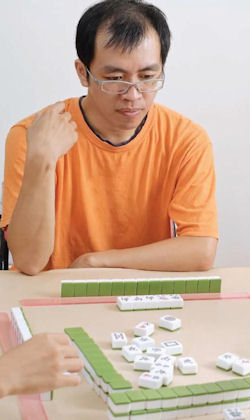This article first appeared in the Mar/Apr 2011 issue of World Gaming magazine.

Remember when you used to play on your grandfather’s lap? How long did it take you to notice he was watching the other players’ hands as well as his own? Remember it seemed like magic he knew your auntie had a huge hand and only needed the 1-dots? That’s why he seemed to win so often.
The fact is that mahjong is played between four players and statistically you can’t win every hand. Once you’ve learned how to make winning hands, it’s just as important to learn how to give up on them, or change them to keep your opponents from winning. Incorporating these defensive tactics into your game will see you losing less, which is just as important as winning more.
Your first priority should always be your own hand. But it’s important to read other players and try to guess what they have and what tiles they need. This takes years of practice. Most types of Asian mahjong allow players to discard tiles anywhere on the board, making this task even more daunting. No matter what kind of rules you’re using, the first thing to do in each hand is to decide if it’s a winning hand or not. There are some hands that will clearly be too slow to beat your opponents’ hands.
Example hand
Giving up this hand is generally your best bet. Conserve your points and keep the other players from getting the tiles they need from you.
Some hands need further judgment after they have been going a while. This is why watching your opponents is so important.
If you’re playing riichi (Japanese-style), Chinese Official rules or WSOM rules, your opponents will line up their discards on the table. This makes it easier to imagine what is in their hand and how they got there. You can see what was discarded and in what order, and you can compare their potential hand to your own. Which one is bigger? Which one is faster? Can they read your hand? Once you can answer these questions it should be easy to decide whether to continue with your hand or not.
Example hand plus drawn tile (you are about to discard)
Let’s say the opponent to your right has called two sets of bams and you’ve noticed they are only discarding craks and dots. This is an obvious flush. Your hand is still three away from winning and you can’t use the remaining bams in your hand. This is a good time to keep those bams and not allow the other player to have any more from you. You have plenty of safe tiles to hold him off and finish the hand in a draw or a smaller win from someone else.
Monster hands in Hong Kong style mahjong are valued much higher than small hands. A smart Hong Kong mahjong defender should be aware of opponents’ hands that are ready (or very close to it). If your own chance of winning is small, you should make sure not to “feed” the player to your right the tiles he needs.
The final defence option is to win quickly. This is the most dangerous way to get in your opponents’ way and leaves you vulnerable, but it is sometimes the best way to end a big hand.
Example hand plus drawn tile (you are about to discard)
This hand has potential to grow into a lot of points, but your opponent is showing three pungs, all value tiles and it’s a monster. You’re not in a position to fold any more but you don’t have the luxury to go for your monster either. Take the ready hand and win the race. Winning a small hand is better than losing a big one.
This method is especially important when you are playing Taiwanese mahjong (also known as 16 tile mahjong). Self-drawn hands award triple points to the winner, so discarding a player’s winner and getting drawn out on costs you the same, and it therefore makes sense to play with an aggressive style.
If you are playing mahjong with people at the same level as yourself, you’ll win less than 25 percent of the hands on average, as some hands end in a draw. So if you know your hand isn’t going to make the cut make sure you start watching the table more closely. Conserving losses is just as important as banking wins and with a little practice your friends and family will start wondering what magic you’re using to come out ahead.







